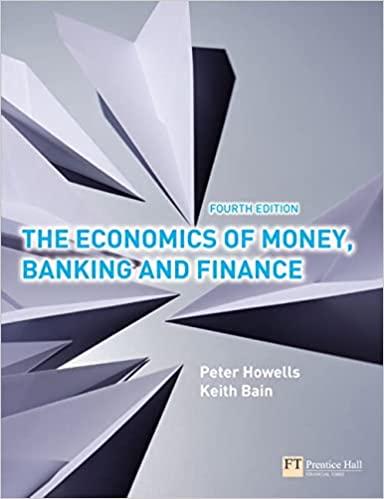Question
A. Even though most corporate bonds in the United States make coupon payments semiannually, bonds issued elsewhere often have annual coupon payments. Suppose a German
A.
| Even though most corporate bonds in the United States make coupon payments semiannually, bonds issued elsewhere often have annual coupon payments. Suppose a German company issues a bond with a par value of 1,000, 25 years to maturity, and a coupon rate of 6.3 percent paid annually. |
| If the yield to maturity is 7.4 percent, what is the current price of the bond |
B.
| A Japanese company has a bond outstanding that sells for 91 percent of its 100,000 par value. The bond has a coupon rate of 5 percent paid annually and matures in 12 years. |
| What is the yield to maturity of this bond (Do not round intermediate calculations and enter your answer as a percent rounded to 2 decimal places, e.g., 32.16.) |
C.
| Say you own an asset that had a total return last year of 11.6 percent. If the inflation rate last year was 6.7 percent, what was your real return? (Do not round intermediate calculations and enter your answer as a percent rounded to 2 decimal places, e.g., 32.16.) |
D.
| Locate the Treasury issue in Figure 7.4 maturing in May 2030. Assume a par value of $10,000. |
| 1. | What is its coupon rate? (Enter your answer as a percent rounded to 3 decimal places, e.g., 32.161.) |
| 2. | What is its bid price in dollars? (Do not round intermediate calculations and round your answer to 2 decimal places, e.g., 32.16.) |
| 3. | What was the previous days asked price in dollars? (Do not round intermediate calculations and round your answer to 2 decimal places, e.g., 32.16.) |
| Bond X is a premium bond making semiannual payments. The bond pays a coupon rate of 7 percent, has a YTM of 5 percent, and has 13 years to maturity. Bond Y is a discount bond making semiannual payments. This bond pays a coupon rate of 5 percent, has a YTM of 7 percent, and also has 13 years to maturity. The bonds have a $1,000 par value. |
| What is the price of each bond today? If interest rates remain unchanged, what do you expect the price of these bonds to be one year from now? In four years? In nine years? In 11 years? In 13 years? (Do not round intermediate calculations and round your answers to 2 decimal places, e.g., 32.16.) |
Step by Step Solution
There are 3 Steps involved in it
Step: 1

Get Instant Access to Expert-Tailored Solutions
See step-by-step solutions with expert insights and AI powered tools for academic success
Step: 2

Step: 3

Ace Your Homework with AI
Get the answers you need in no time with our AI-driven, step-by-step assistance
Get Started


